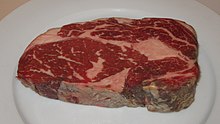
In French, entrecôte (French pronunciation: [ɑ̃.tʁə.kot]) is a premium cut of beef used for steaks and roasts.

A traditional entrecôte is a boneless cut from the rib area[1][2] corresponding to the steaks known in different parts of the English-speaking world as rib, rib eye, Scotch fillet, club, or Delmonico.
The muscle group concerned is the longissimus dorsi, which runs down the back of the animal adjacent to the vertebrae and above the rib cage, and continues into the hind quarter. Once past the rib cage into the area adjacent to the lumbar vertebrae, this muscle group is no longer called an "entrecôte"—at that point it becomes a sirloin/strip steak (UK/N.Am, respectively), or a contre-filet in French.
Images[edit]
-
Localisation of ribs and the entrecôte
-
A grilled entrecote with french fries
See also[edit]
References[edit]
- ^ "entrecôte". Merriam-Webster.com Dictionary. Retrieved 2019-07-29.
- ^ Danilo Alfaro (2019-07-15). "What Is Entrecôte?".


Well, that’s interesting to know that Psilotum nudum are known as whisk ferns. Psilotum nudum is the commoner species of the two. While the P. flaccidum is a rare species and is found in the tropical islands. Both the species are usually epiphytic in habit and grow upon tree ferns. These species may also be terrestrial and grow in humus or in the crevices of the rocks.
View the detailed Guide of Psilotum nudum: Detailed Study Of Psilotum Nudum (Whisk Fern), Classification, Anatomy, Reproduction